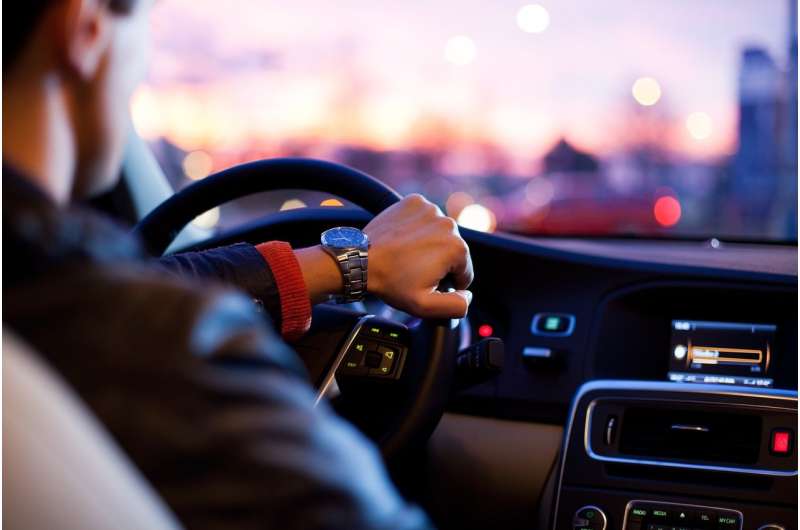Slow music in tunnels can keep drivers focused and safe

Driving through a tunnel is a challenging and risky task. Drivers need to lower their speed and adapt to poor light, while the enclosed space may make them anxious. Preventing accidents is a public health challenge that uses insights from engineering, psychology, physiology, and neuroscience. Here, in a virtual reality (VR) study in Frontiers in Psychology, scientists from China, Canada, and the USA show that playback of slow music inside tunnels can reduce tension and fatigue in drivers, making them less prone to speeding and overtaking. These results imply that well-chosen background music can help improve road safety.
“When drivers go through a tunnel, they need to process a large amount of information quickly. We wanted to find the best way to use sound to keep drivers alert and focused inside tunnels. We here compare the effect on brain activity and physiology of different types of sound: slow versus fast music, warning sounds such as sirens, and a voice reminding them to drive safely,” says corresponding author associate professor Yanqun Yang from the Transportation Research Center in College of Civil Engineering at Fuzhou University, China. “We show that the best solution is to play slow music inside the tunnel, but to play alarming sounds like sirens at the entry and exit or during emergencies.”
Rate of accidents depends on location within tunnels
Previous research has found that accidents are less frequent in tunnels than on open roads, but that accidents that do happen inside tend to be more serious. Nor is the rate of accidents the same along a tunnel’s length: for example, accidents are more likely just before or after the entrance. Once drivers are acclimatized to the special environment inside, they tend to reduce speed and move away from the tunnel wall, causing the rate of accidents to decrease. Accidents become more likely again over the middle stretch in long tunnels, because drivers may relax their vigilance from boredom.
The authors here studied whether background sounds and music might help to keep drivers relaxed but focused over the length of a long tunnel. With immersive VR, they simulated a 5100-m-long four-lane tunnel with traffic in both directions, driving between 80 and 100 kmph. They recruited 40 young women and men to act as experimental drivers—these people watched the VR on screens while inside a console that continuously recorded the pressure on the pedals, the steering wheel’s angle, driving speed, and acceleration.
Yang et al. used wireless sensors to compare the drivers’ neurophysiological response to five experimental sounds: a recording from a real tunnel, the slow music song “Canon” with 72 beats per minute (bpm), the fast song “Croatian rhapsody” with 96 bpm, a police siren, and a female voice warning “Please turn on the lights, slow down, and no-overtaking” or “Here is an accident blackspot, please turn on the lights and slow down.”
They measured skin electrical conductance as a proxy for ‘arousal’, which encompasses attention, vigilance, and memory storage. Measures of heart rate and its variability served as proxies for emotional state, stress, mental load, and fatigue, while EEG measures of the brain’s activity were used as proxies for wakefulness, fatigue, relaxation, and nervousness.
Slow music stimulated drivers to drive safely
Drivers drove fastest in response to fast music, and slowest in response to slow music. Comparisons of heart rate variability—typically low in people who are stressed—indicated that the drivers felt most relaxed, with a minimal mental load, when listening to slow music. This was consistent with feedback from drivers, of whom 63% chose the slow music as their preferred background.
Comparisons of the drivers’ β brain waves—typically elevated in persons who are nervous or excited, and hence prone to fatigue—indicated that slow music reduced nervousness in the drivers, while voice prompts, fast music, and sirens increased it. Comparisons of the relative patterns of α, β, and θ waves—often combined in research to yield measures of fatigue—indicated that the voice prompt was most effective in preventing tiredness.
Best solution: A combination of slow music with occasional sirens
The authors conclude that safety would increase if slow music would be played as a background in tunnels, while sirens should be played only at the entry, exit, and during emergencies.
“We find that slow music played as background throughout the tunnels, replaced by sirens only at spots and times when the risk of accidents is highest, is best to keep drivers alert, at ease, and not tired, while stimulating them to be extra vigilant and focused when needed,” says coauthor Dr. Wei Lin from the Department of Civil and Architectural Engineering and Construction Management at the University of Cincinnati, USA.
Source: Read Full Article



